Previous news
Signing of an R&D contract to verify a possible therapeutic approach against Alzheimer's disease |
29-11-2012 |
The CSIC has signed an R&D contract with the biotechnology company Tetraneuron for the development of agents able to block neuronal tetraploidization...
 |
La fórmula de las decisiones en grupo
(Spanish) |
27-11-2012 |
Un individuo aislado se basa en la información que le rodea y en sus experiencias previas para tomar una decisión. No obstante, dentro de un colectivo, esta opción está influenciada por las decisiones individuales que elije cada miembro del grupo. Una investigación del Consejo Superior de Investigaciones Científicas (CSIC) ha desarrollado una fórmula matemática que refleja la probabilidad de escoger una u otra opción dentro de un grupo de la misma especie. Dicha fórmula apareció recogida ayer en la revista Proceedings of the National Academy of Sciences (PNAS).

|
A study published in Development reveals a mechanism that prevents alterations in neuronal production during the development of the vertebrate nervous system |
6-06-2012 |
A multidisciplinary team from the Cajal Institute, the National Center for Biotechnology, and the University of Barcelona has discovered that the lateral inhibition process during neurogenesis, known to be regulated by the Notch receptor and its ligand Delta, is altered a the neurogenic wavefront (i.e. the edge between the expanding region of the neuroepithelium showing neurogenic capacity and the adjacent non-neurogenic area).
 |
 |
Researchers at the Cajal Institute discover common features in the proteins that trigger neurodegenerative diseases |
30-05-2012 |
A study reveals common features in the
proteins that trigger neurodegenerative
diseases
• The results may provide new targets for prevention, early
diagnosis and therapy of these devastating diseases.
• It has been published in the last issue of ‘PLoS Biology’,
being selected as a journal cover with a special comment.
______________________________________________________________________________________
Rubén Hervás, Javier Oroz, Albert Galera‐Prat, Oscar Goñi, Alejandro Valbuena, Andrés M Vera, Àngel
Gómez‐Sicilia, Fernando Losada‐Urzáiz, Vladimir N. Uversky, Margarita Menéndez, Douglas V
Laurents, Marta Bruix, Mariano Carrión‐Vázquez (2012). Common Features at the Start of the
Neurodegeneration Cascade. PLoS Biol 10(5): e1001335. doi:10.1371/journal.pbio.1001335.
Janelle Weaver (2012) Single‐Molecule Technique Links Structural Fluctuations of Proteins
to Brain
Diseases. PLoS Biol 10(5): e1001338. doi:10.1371/journal.pbio.1001338.
 |
Identification of signals coordinating formation of the peripheral
nervous system during embryonic development
|
10-08-2011 |
FGF and retinoic acid activity gradients control the timing of neural crest cell emigration in the trunk. Patricia L. Martínez-Morales, Ruth Diez del Corral, Isabel Olivera-Martínez, Alejandra C. Quiroga, Raman M. Das, Julio A. Barbas, Kate G. Storey, and Aixa V. Morales. 2011. The Journal of Cell Biology. 194:489-503. Doi:10.1083/jcb.201011077.
 |
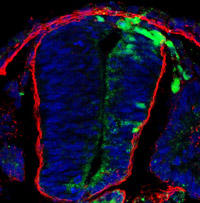 |
New Research: "The relationship between animal behavior in gusts and decision making" |
27-06-2011 |
The de Polavieja Lab at the Cajal Institute has recently published an article in PLoS Computational Biology, the leading journal in Computational Biology featuring works of exceptional significance in Biology using computational methods.
 |
Transition to seizure in human epilepsy |
8-04-2011 |
Brief and synchronous inter-ictal events can occur between seizures. Using
human tissue samples and electroencephalography, a recent study by Liset
Menendez de la Prida and her colleagues Richard Miles and Gilles Huberfeld
shows that the transition from pre-ictal discharge to ictal discharge
involves distinct temporal and spatial characteristics as well as
glutamatergic mechanisms.
 |
|
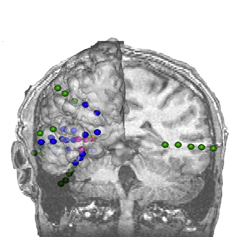
|
Uncovered a novel mechanism regulating neurogenesis in the vertebrate nervous system |
18-11-2011 |
The so-called “Neuronal Generation and Degeneration in Vertebrates” group of the Cajal Institute has been actively working for years on the analysis of the mechanism regulating the expression and function of proneural and neurogenic genes during the cell cycle in neural precursor cells.
 |
|

|
| FUNDALUCE award for research in hereditary retinal dystrophies to Paola Bovolenta. |
25-11-2010 |
El viernes 26 de noviembre, a las 18:00 h., se celebra la XII Jornada de entrega de Premios a la Investigación “Fundación Lucha contra la Ceguera” (FUNDALUCE), con el lema: “La ceguera puede vencerse. Alternativas terapéuticas”. En dicho marco se entregará la Ayuda 2009 a la Investigación en Distrofias Hereditarias de Retina otorgada por FUNDALUCE a la Dra. Dña. Paola Bovolenta.  |
New multi-site probes developed by the team of Liset M. de la Prida |
19-11-2010 |
The team leaded by Dr. Liset Menendez de la Prida is interested in designing
and producing new multisite probes for high-density single-cell recording
and integrated functionalities, including microfluidity channels, new
material coating and optical stimulation. This research programme is funded
by an ERANET-NEURON project.

|
|
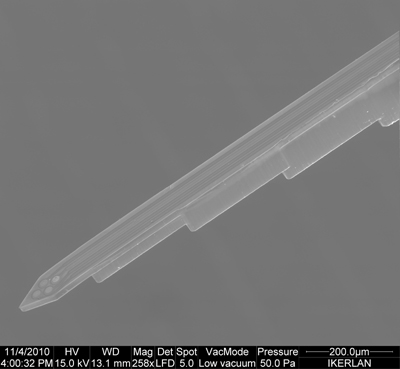
|
| Deciphered the mechanism that adjusts the number of neurons to the body size |
03-09-2010 |
Peripheral neurons are produced in high numbers, a process followed by the death of those neurons that do not have access to the neurotrophins nerve growth factor (NGF) or neurotrophin-3 (NT3). An international team including a member of the Cajal Institute has found that it is the expression of the NGF and NT3 receptors TrkA and TrkB what induces apoptosis in neurons lacking their ligands. In contrast, the brain-derived neutrophic factor (BDNF) receptor TrkB, which is highly expressed in the central nervous system, does not induce neuronal death in the absence of its ligand. Therefore, the classical neurotrophic mechanism promoted by NGF and NT3 in the peripheral nervous system seems to have raised during vertebrate evolution in parallel with the diversification of the Trk receptors, which have acquired proapoptotic activity in the peripheral nervous system.
Nikoletopoulou, H. Lickert, J. M. Frade, C. Rencurel, P. Giallonardo, L. Zhang, M. Bibel, Y. Barde. Neurotrophin receptors TrkA and TrkC cause neuronal death whereas TrkB does not. Nature (2010) 467: 59-64. |
|

|
| The "vicious cycle" that
spread neuronal degeneration
in Alzheimer patient has been described |
26-07-2010 |
Alzheimer’s disease (AD) is characterized by progressive neuronal degeneration throughout different cerebral regions, a process initiated at the basal forebrain. Researchers from the Cajal Institute have proposed a hypothesis to explain this dynamic process. They propose the existence of a feedback cycle that propagates neuronal degeneration in the AD brain. Oxidative stress would favor the expression of NGF, a neurotrophin known to activate the membrane receptor p75 triggering cell cycle progression and DNA duplication.  |
|

|
| European ERANET NEURON project for Liset Menendez de la Prida |
02-02-2010 |
Liset Menendez de la Prida (Instituto Cajal, CSIC), along with Heinz Beck
and the Research Center Caesar in Bonn (Germany) , Rosa Cossart (France) and
Ilan Lampl (Israel) has been selected in the 2009 call of the European
Eranet Neuron initiative with the project: "EPINET: Understanding and
manipulating epileptic networks with optical stimulation and advanced
population recording techniques". The major goal is to bring together a
number of novel techniques in neuroscience research to the study of
epilepsy, with a especial emphasis on open questions regarding changes in
dendritic processing, microcircuit reorganization and altered hippocampal
oscillations. The techniques include i) multiphoton uncaging and imaging
techniques, ii) optogenetic stimulation techniques, iii) multi-electrode and
optical population recording techniques that simultaneously sample activity
from many neurons, and iv) in-vivo multi-unit and patch-clamp recording
techniques in freely moving animals. |
| Foundation stone laying ceremony celebrates the construction start for a new Cajal Institute headquarter. |
20-01-2010 |
Laying of the first stone of the definitive headquarter of the Cajal Institute. The new headquarter of the Cajal Institute will be built on land ceded by the Alcala de Henares University. New building will occupy an area of about 20,000 square meters . 
|
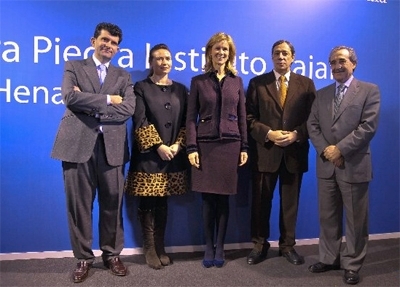 |
| European Project for Eranet SysBio + 2010 Gonzalo García de Polavieja |
29-12-2009 |
Gonzalo García de Polavieja (Instituto Cajal, CSIC), along with German sumbrad (ENS, France), Uwe Straehle (ITG, Germany) and Elad Schneideman (Weizmann, Israel) has obtained a European project Eranet SysBio + 2010 titled "Understanding making decisions based on the dynamics of neuronal populations in zebrafish."  |
| Discovered a novel mechanism generating DNA duplication in neurons |
15-12-2009 |
Tetraploid neurons are nervous cells containing double the normal amount of DNA in their nuclei and, therefore, of large size. These neurons are believed to arise from aberrant divisions during the development of the nervous system, and their presence in the brain has been associated with neurodegenerative diseases such as Alzheimer’s disease. A study led by a group of the Cajal Institute demonstrates that a molecular mechanism exist during development leading to the generation of tetraploid neurons. This finding, included in the last issue of Proceeding of the National Academy of Sciences of the United States of America, shed new light on the mechanisms involved in nervous system development and the origin of neurodegenerative diseases.  |
| Jornadas Científicas de Navidad en el Cajal - días 21 al 23 de December |
09-12-2009 |
Como cada año el Cajal Institute va a celebrar las Jornadas Científicas de Navidad. Este año han sido organizadas por las Comisiones de Seminarios e Institucional y hemos cambiado un poco el formato. El mayor cambio ha sido el integrar en nuestro programa científico a jóvenes investigadores que actualmente trabajan como investigadores postdoctorales en el extranjero. Pretendemos que estos investigadores den a conocer su trabajo en nuestro Instituto, a fin de generar espacios de interacción de cara a futuras incorporaciones o colaboraciones.  |
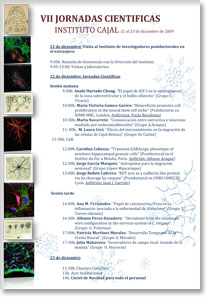 |
| "Reunión conjunta del Instituto de Neurociencias y del Cajal Institute." |
18-11-2009 |
Los próximos dias 16 y 17 de November de 2009 se celebrará en la ciudad de Cuenca una reunión conjunta del Instituto de Neurociencias de Alicante con el Cajal Institute, ambos centros pertenecientes al CSIC -Consejo Superior de Investigaciones Científicas-.
Activities Program |
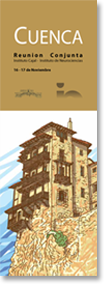 |
|
| "Formulan una teoría que explica rasgos aparentemente mal optimizados durante la evolución ." |
11-11-2009 |
Muchos sistemas biológicos son prácticamente óptimos para las funciones que realizan. Es el caso del sistema nervioso que, según observo Santiago Ramón y Cajal, está optimizado para utilizar la mínima cantidad de cable posible, ahorrando así costes y espacio.  |
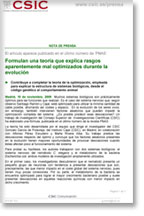 |
|
| "Genetic inactivation of dopamine D1 receptors, but not D2 receptors, inhibits dyskinesia and histone phosphorylation induced by L-DOPA." |
02-10-2009 |
Pharmacological studies have implicated dopamine D1-like receptors in the development of L-DOPA-induced dyskinesias and associated molecular changes in hemiparkinsonian mice..  |
 |
|
| "Identified the strongest protein ever known." |
11-9-2009 |
► escafoldina, una proteína bacteriana, es el doble de robusta que la proteína más resistente conocida hasta la fecha: la titina, el ‘muelle biológico’ de los músculos
► El estudio sugiere que la escafoldina podría tener potenciales aplicaciones en la mejora de métodos de obtención de bioalcohol y en el desarrollo de microchips.  |
|
| "Un estudio describe el papel de los astrocitos en la migración de neuronas a su destino." |
5-8-2009 |
El fenómeno de generación masiva de neuronas que ocurre cada día en el cerebro implica la migración de miles de neuronas que deben moverse varios milímetros entre su origen y su destino final.  |
|
|
| "Blockade of IL-15 activity inhibits microglial activation through the NF B, p38, and ERK1/2 pathways, reducing cytokine and chemokine release." |
16-07-2009 |
La activación microglial es un fenómeno gobernado por la acción de moléculas inflamatorias, en el curso de las enfermedades neurodegenerativas o los fenómenos traumáticos en el sistema nervioso central. Un reciente estudio publicado en GLIA describe el modo de acción de un factor clave en el desarrollo de dicha activación, la interleuquina 15. La acción de esta molécula permite la coordinación de la activación microglial, apareciendo el uso de estrategias bloqueantes de su actividad como una interesante estrategia antiinflamatoria. |
|
|
|